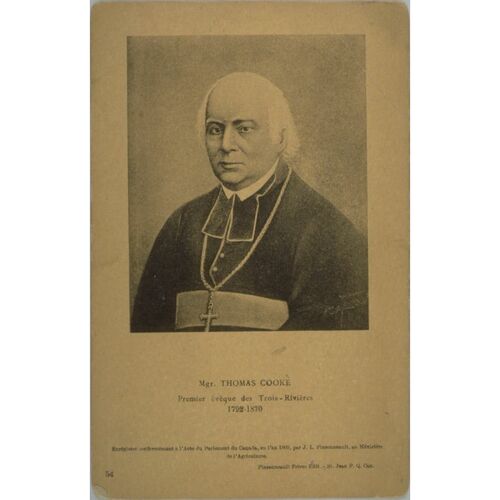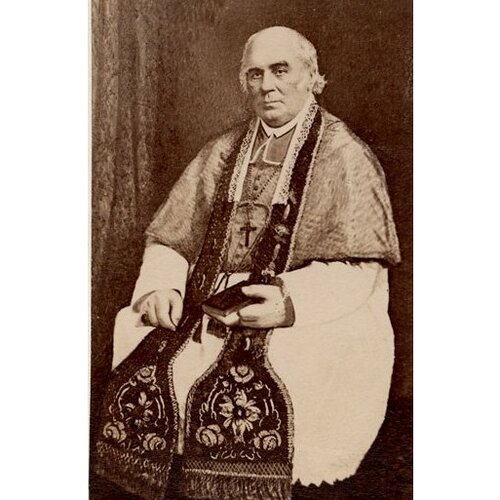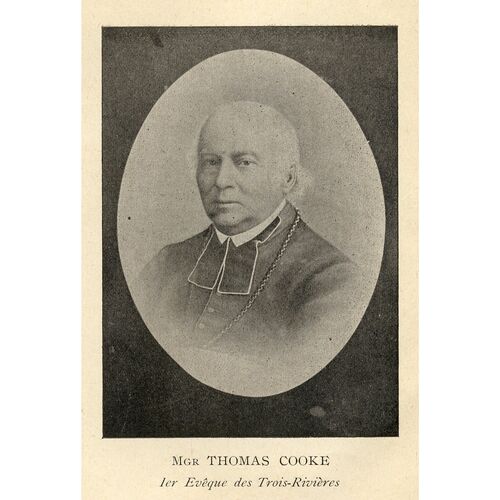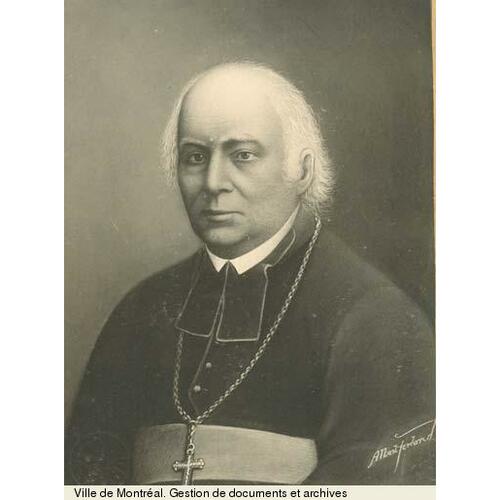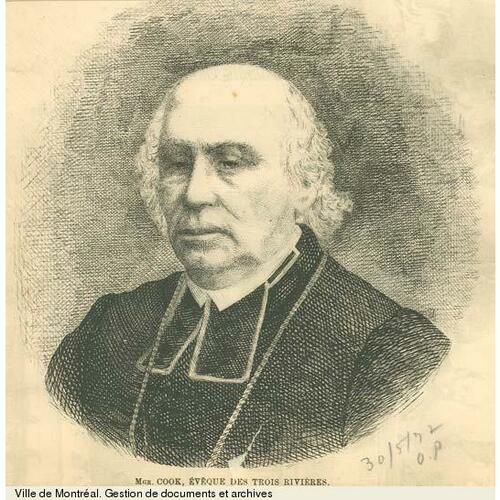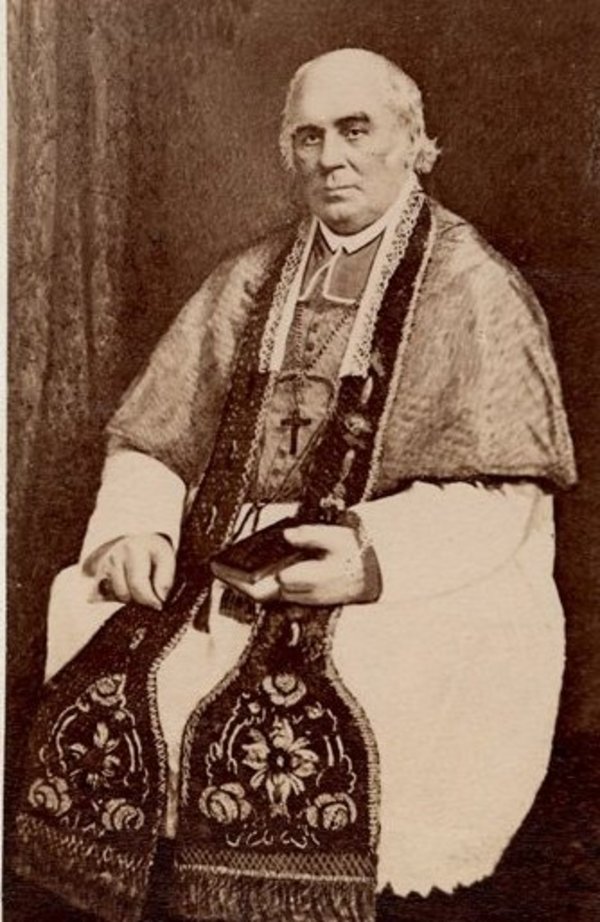
Source: Courtesy of Wikimedia Commons
COOKE, THOMAS, Catholic priest, missionary, bishop; b. 9 Feb. 1792 at Pointe-du-Lac, Lower Canada, eldest son of John Thomas Cooke and Isabelle Guay; d. 31 March 1870 at Trois-Rivières.
Thomas’ father, a native of Ireland, ran away from home and stowed on a ship bound for Canada. The captain soon discovered him, and on reaching Montreal placed him under the care of the commandant of Île Sainte-Hélène, through whose initiative he was trained as a miller. Around 1790 John Thomas Cooke went to Pointe-du-Lac, where he worked at the mill of seigneur Nicolas Montour*, then became a miller at Cap-de-la-Madeleine; he was murdered in December 1808.
By then Thomas was already a boarder at the Grand Séminaire de Québec. The parish priest, Urbain Orfroy, had introduced him to French and Latin and then sent him in 1804 to the Collège de Nicolet, which had just opened. There he had shown himself “ingenious and virtuous,” and his superiors had invited him to take his philosophy at the seminary of Quebec, starting in the autumn of 1808. A year later, Bishop Joseph-Octave Plessis* appointed him professor of Latin and bursar at the new Collège de Saint-Hyacinthe. He returned to the Grand Séminaire de Québec in 1811, and while studying theology acted as form-master and professor at the Petit Séminaire. Bishop Plessis ordained him priest on 11 Sept. 1814.
The new priest immediately found himself fully occupied. He was both curate at Rivière-Ouelle and secretary to the parish priest, Bishop Bernard-Claude Panet*, coadjutor to the bishop of Quebec. In four years he officiated at 508 baptisms, 125 marriages, and 221 burials, as well as dealing with the coadjutor’s heavy correspondence. In the autumn of 1817 Bishop Plessis, pleased with his work, appointed him missionary at Baie des Chaleurs. Abbé Cooke immediately took Caraquet, N.B., as his centre for the missions entrusted to his care, from Belledune to the Baie du Vin. For six years he continually travelled throughout his vast territory to bring the comfort of religion to a thousand scattered settlers. He spread the gospel, did not mince his words with the varied population of Micmacs, Acadians, Irish, and Scots, and was not afraid to resort to extreme measures (expulsion from the church, a good caning) to correct drunkenness and loose living; he also became a builder and started or completed the construction of five churches and two presbyteries. The young missionary gave so much of himself that his health was affected, and in 1822 he had to ask to be recalled. He left Caraquet for good in November 1823.
After a few months’ rest at Pointe-du-Lac, Abbé Cooke was appointed parish priest of Saint-Ambroise-de-la-Jeune-Lorette (Loretteville), with responsibility for the parish’s Indian mission and the Irish settlement at Valcartier. Here he spent the most rewarding years of his life. His parishioners appreciated his piety and charity; he was unsparing in his devotion to his white parishioners, and even more to the Indians, for whom he had a particular affection; as a change from his labours, he taught school to young Canadians and Hurons, and accompanied soldiers on their fishing expeditions, where he proved to be a good companion, “gay, teasing, even a songster, as soon as he stepped into a fishing boat.” He none the less continued to direct his parish “like a religious community.”
Because of his reputation the bishop of Quebec appointed him parish priest of Trois-Rivières, a parish where piety and good order left something to be desired. Abbé Cooke arrived there in September 1835, with the titles of parish priest of Trois-Rivières and Cap-de-la-Madeleine, vicar general, and member of the corporation of the Séminaire de Nicolet. He immediately set to work. According to a contemporary, “he made ingenious use of everything [retreats, indulgences, confraternities] to achieve his ends: the improvement and sanctification of his flock.” He brought in Abbé Charles-Paschal-Télesphore Chiniquy* and Bishop Charles-Auguste-Marie-Joseph de Forbin-Janson*, who by their eloquence profoundly stirred the people of Trois-Rivières and inaugurated there as elsewhere in Lower Canada an era of Catholic revival.
Thomas Cooke was appointed first bishop of the diocese of Trois-Rivières on 8 June 1852 and consecrated on 18 October. The diocese extended from Maskinongé to Sainte-Anne-de-la-Pérade, from Yamaska to Saint-Pierre-les-Becquets, and from the upper Saint-Maurice to the American border. The new office changed him little, for he remained above all a parish priest and pastor. Unfailingly courteous with laymen and gentle with children, Bishop Cooke became increasingly demanding of himself and others. An impetuous Irishman, he readily lost his temper, and blasted offenders without compromise or equivocation, but his anger almost always ended in a resounding laugh which disconcerted those who did not know him intimately; he was a witty and skilful talker, and his conversation was enlivened by clever and piquant rejoinders which sometimes went beyond acceptable limits. His charity was proverbial at Trois-Rivières, where he always showed himself a lover of order and justice. Bishop Cooke stayed out of ideological quarrels, for, according to a contemporary, “he understood little about the questions that so engrossed the minds of some.” Thus in 1863, when he was obliged to take a stand concerning the creation of a Catholic university at Montreal, he wrote to the archbishop of Quebec: “I shall vote as Your Excellency does, if you are against it. You will please be good enough to inform me, indeed to send me a résumé of the reasons that I can use in my reply.” In 1867 he left it to his coadjutor, Bishop Louis-François Laflèche*, to draw up a text which was strongly in favour of confederation, and he agreed to sign it although he considered it “too political.”
Bishop Cooke’s achievements during his episcopacy were not all spectacular, for he wanted first to organize the new diocese. He was alert to the needs of his flock and clergy; he gave particular attention to pastoral visits, and established ecclesiastical conferences and an annual retreat for his priests. Despite the manifest opposition of a section of the clergy, who favoured developing the Collège de Nicolet, and of the faithful, who were already sufficiently in debt, he allowed the college of Trois-Rivières to be established in 1860, and undertook to provide ecclesiastical staff for it. The cathedral of Trois-Rivières is the principal monument commemorating his episcopacy. He announced its construction in a pastoral letter of 16 March 1854, and requested the people of his diocese to contribute to the building of this mother church. Some of the faithful found the burden too heavy and protested. Moreover, through inept speculation and bad financial administration, the diocese was on the verge of bankruptcy. Indeed, anticipating the construction of a northern railway, the bursar had bought a large number of building sites at Trois-Rivières. But the railway did not appear, the land did not increase in value as anticipated, and the episcopal corporation was obliged to sell at a low price. Building of the cathedral was undertaken all the same and it was consecrated on 29 Sept. 1858. But Bishop Cooke was soon forced to disclose his financial difficulties. His clergy and people were warned, and Abbé Louis-François Laflèche was instructed to visit all the parishes in the diocese and meet all the creditors. Through generous gifts and private settlements bankruptcy was averted, and the debt of $96,000 wiped out in the years that followed. Bishop Cooke came into conflict with some of his clergy over another issue concerning money. In December 1856, by decree, he required the parish priests to pay him ten per cent of their revenues. The richest priests, particularly those on the south shore, challenged the bishop’s right to impose a levy on them. The dispute assumed dangerous proportions before it was resolved by compromises in 1857 and 1862, when promissory notes given by the parish priests replaced the real ten per cent. But a certain animosity remained as a forewarning of the extensive manoeuvring from 1870 to 1880 to get a diocese created at Nicolet.
Endless toil, continual difficulties, and particularly the divisions among clergy and faithful, rapidly undermined the bishop’s health. Increasingly crippled by rheumatism, and weakened by heart disease and leg pains, Bishop Cooke gradually handed over his powers to his successor. In September 1861 he took Abbé Louis-François Laflèche out of the Séminaire de Nicolet, appointed him bursar of the bishopric, and gave him full authority to clear up the financial situation; in 1867 he made him his coadjutor cum futura successione, and after 11 April 1869 entrusted him fully with the administration of the diocese. Bishop Cooke spent his remaining months in increasing seclusion, giving himself to meditation and devotions to the Virgin and St Joseph. He died on 31 March 1870, aged 78 years and one month.
AAQ, 311 CN, VI. Archives du séminaire de Nicolet (Nicolet, Qué.), Lettres des directeurs et autres à l’évêque de Québec, 1814–74, I–V. ASTR, Papiers Mgr Albert Tessier, Q1, C20. L’Opinion publique, 30 mai, 6 juin 1872; 6 févr. 1879. Marie-Stanislas-du-Sacré-Cœur, “Introduction à une biographie de Mgr Thomas Cooke” (thèse de des, université Laval, Québec, 1965). Les ursulines des Trois-Rivières depuis leur établissement jusqu’à nos jours (4v., Trois-Rivières, 1888–1911). Edgar Godin, “Mgr Thomas Cooke, missionnaire de la baie des Chaleurs, 1817–1823,” SCHÉC Rapport, 20 (1952–53), 43–48.
Cite This Article
Nive Voisine, “COOKE, THOMAS,” in Dictionary of Canadian Biography, vol. 9, University of Toronto/Université Laval, 2003–, accessed March 28, 2025, https://www.biographi.ca/en/bio/cooke_thomas_9E.html.
The citation above shows the format for footnotes and endnotes according to the Chicago manual of style (16th edition). Information to be used in other citation formats:
| Permalink: | https://www.biographi.ca/en/bio/cooke_thomas_9E.html |
| Author of Article: | Nive Voisine |
| Title of Article: | COOKE, THOMAS |
| Publication Name: | Dictionary of Canadian Biography, vol. 9 |
| Publisher: | University of Toronto/Université Laval |
| Year of revision: | 1976 |
| Access Date: | March 28, 2025 |


